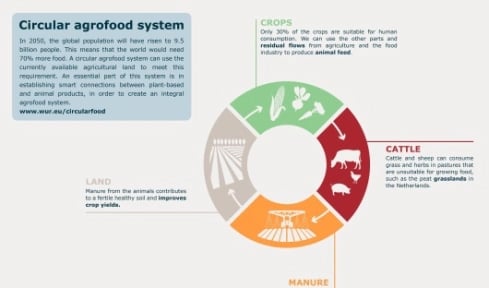Circular Agriculture
History tells us , Dutch are successful traders. In industry driven market farmers must look beyond their fields and towards the market.
-Abhinav Balyan
For more than half a century, Dutch and European agricultural policy has focused on efficiently producing as much food as possible for a low price and with a reasonable income for the farmers. Using this policy that was developed by the legendary Sicco Mansholt, Dutch agriculture attracted admiration from beyond its borders and grew into a nation with the second-largest agricultural output in the world.
This great success of the last half century, however, is not a guarantee for the future. Time has come in our view, to think about the next steps, the transition towards a truly sustainable agriculture. Efficient production remains necessary, especially because the demand for food and other agricultural products and resources only continues to grow. The need to produce affordable, safe and healthy food, not just for the country but also for Europe and the world will continue for at least another half century. But the concepts of intensification and efficiency, however powerful they have been, are not enough. They need to be transformed into optimization of the use of all resources, not just at the level of the farm, but also broader at local, regional, national and transnational levels. Optimization of the interlocking systems at different scales is fundamentally different from maximization at the field, stable, greenhouse or farm level. It allows us to use land, water, chemicals and nutrients to optimal effects and to reduce or even eliminate the waste of residual biomass since this can be used elsewhere in the food system. This is indeed a fundamental transition requiring mental and policy adjustments. Moreover, it entails trade-offs because choices need to be made about what the best route to optimization is. It is the role of science to present clearly the costs and benefits of different types of transitions.
Circular agriculture
“Kringlooplandbouw” (circular agriculture), in which a new perspective is outlined for Dutch agriculture. This note was discussed in a technical briefing with the agricultural committee of the Dutch Parliament in mid-June. At 8 September, the Dutch minister of agriculture, nature and food quality, launched here vision on the transition of the Dutch agriculture in a direction of circularity.Let’s start with what it is ! Circular agriculture does not mean that we will return to the rural nostalgia of the early 1900s. Images from the period sometimes suggest a wonderful time that never existed: agriculture struggled with a high degree of illness, too little fertiliser, and the continuous risk of a bad harvest. Circular agriculture is not a blueprint meant to strangle farming businesses even further with oppressive dogmas, market requirements and government regulations.
Circular agriculture is a collective search by farmers, interested citizens, businesses, scientists and researchers for the optimum combination of ecological principles with modern technology, with new partnerships, new economic models, and credible social services. It not only focuses on good yields and the sparing use of resources and energy, but also stresses the importance of putting as little pressure on the environment, nature and climate as possible.
Healthy soil is the foundation
Agricultural production depends on healthy soil life and a good soil structure. The health of the soil is largely determined by the quality of the organic material it contains, the balance in groundwater dynamics and the availability of nutrients that are essential for people, animals, and crops: nitrogen, phosphorus, potassium, and a wide range of micronutrients.
Loss of nutrients leads to air, water, and ground pollution and a loss of biodiversity. It also exhausts limited resources, such as phosphate, which is then supplemented with mined fertilisers or low-quality manure slurries.
Due to the crucial role of nutrients in the cycle, healthy soil is one of the most important foundations for circular agriculture. Soil fertility and, primarily, the quantity of organic material are not only determining factors for crop yield, but also ensure that nutrients, trace elements, and water are better retained. Not to mention that in healthy fields with healthy soil life, there are fewer illnesses and pests. Something also worth noting: increasing the level of organic materials is a natural way to absorb and contain CO2 and other greenhouse gases.
In circular agriculture, soil life is optimally nourished using a resourceful combination of good quality animal-based fertiliser, preferably composted manure and crop remnants. Animal manure will no longer be stored in liquid form in the manure pit, but will be separated at the farm into dry (faeces) and wet (urine). Another interesting source of nutrients is sanitised sewage sludge originating from domestic wastewater treatment and process water from food industries.
Even when reuse is maximised, a nutrient loss in the cycle is inevitable. Shortages can be supplemented by including nitrogen-fixing crops in the rotation and through targeted use of artificial fertiliser, depending on the growth stage of the crop. Thanks to new technology, this can now be detected in practice at the level of the individual plant through tools such as leaf-colour sensors. The great advantage of precision fertilisation is not only that less fertiliser is required, but that it also reduces loss to the environment.


